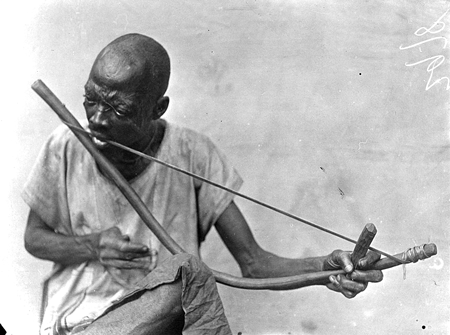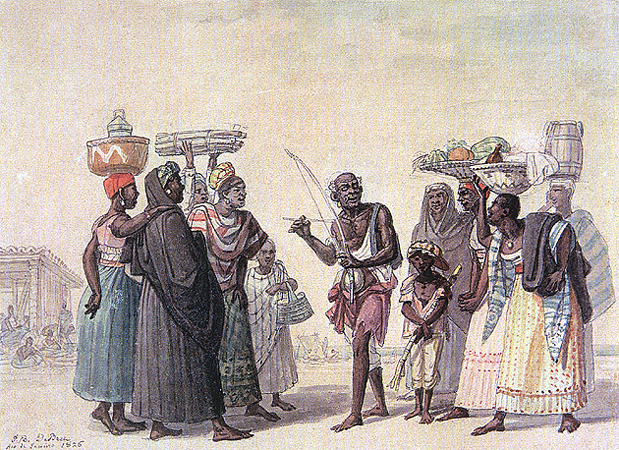|
Malunga
The ''malunga'' is a single-stringed musical bow played by the Siddi of India, who are the descendants of East African immigrants. It produces two tones, an octave apart, and the knuckle of the hand supporting the instrument may be pressed against the string to vary the pitch. It is struck with a stick and, as with the ''berimbau'' of Brazil, the hand holding the stick also holds a rattle (in the case of the ''malunga'' the rattle, called ''mai misra''). The ''malunga'' has a gourd resonator which amplifies the instrument's sound. The placement of this rattle along the string also varies the pitch produced by the Malunga. Construction The bow is made of solid-core bamboo cane, and the string is made of three twisted strands of gut. The gourd resonator is made from a coconut shell and is a mobile part of the instrument. Cultural importance The ''malunga'' is one of the instruments that is used in the religious practices of the Siddi people in India. This instrument is one of the ... [...More Info...] [...Related Items...] OR: [Wikipedia] [Google] [Baidu] |
Musical Bow
The musical bow (bowstring or string bow, a subset of bar zithers) is a simple string instrument used by a number of African peoples as well as Indigenous peoples of the Americas. It consists of a flexible, usually wooden, stick 1.5 to 10 feet (0.5 to 3 m) long, and strung end to end with a taut cord, usually metal. It can be played with the hands or a wooden stick or branch. It is uncertain if the musical bow developed from the hunting bow, though the San or Bushmen people of the Kalahari Desert do convert their hunting bows to musical use. Types of bow include mouth-resonated string bow, earth-resonated string bow, and gourd-resonated string bow. History There is speculation that the hunting bow may have been used as a musical instrument from as early as circa 13,000 B.C. Henri Breuil surveyed the Trois Frères in France caves and made an engraving that attempted to reproduce a c. 13,000 B.C. cave painting into a black-and-white lithograph engraving. His engra ... [...More Info...] [...Related Items...] OR: [Wikipedia] [Google] [Baidu] |
Berimbau
The berimbau (, borrowed from Kimbundu ''mbirimbau'') is a traditional Angolan musical bow that is commonly used in Brazil. It is also known as ''sekitulege'' among the Baganda and Busoga. It consists of a single-stringed bow attached to a gourd resonator and is played with a stick and a coin or stone to create different tones and rhythms. The berimbau was used in many parts of Africa and Brazil during the 19th century to accompany chants and storytelling. It is part of the candomblé tradition, later incorporated into the Afro-Brazilians, Afro-Brazilian art capoeira. Until the mid-20th century, it was used almost exclusively within the black community, but after the popularization of capoeira, it gain wider popularity. Today, berimbau is used in various genres of popular music. History Berimbau is an adaptation of African gourde musical bows, as no Indigenous peoples in Brazil, Indigenous Brazilian or European people use musical bows. According to the musicologist Gerard K ... [...More Info...] [...Related Items...] OR: [Wikipedia] [Google] [Baidu] |
Musical Bow
The musical bow (bowstring or string bow, a subset of bar zithers) is a simple string instrument used by a number of African peoples as well as Indigenous peoples of the Americas. It consists of a flexible, usually wooden, stick 1.5 to 10 feet (0.5 to 3 m) long, and strung end to end with a taut cord, usually metal. It can be played with the hands or a wooden stick or branch. It is uncertain if the musical bow developed from the hunting bow, though the San or Bushmen people of the Kalahari Desert do convert their hunting bows to musical use. Types of bow include mouth-resonated string bow, earth-resonated string bow, and gourd-resonated string bow. History There is speculation that the hunting bow may have been used as a musical instrument from as early as circa 13,000 B.C. Henri Breuil surveyed the Trois Frères in France caves and made an engraving that attempted to reproduce a c. 13,000 B.C. cave painting into a black-and-white lithograph engraving. His engra ... [...More Info...] [...Related Items...] OR: [Wikipedia] [Google] [Baidu] |
Berimbau
The berimbau (, borrowed from Kimbundu ''mbirimbau'') is a traditional Angolan musical bow that is commonly used in Brazil. It is also known as ''sekitulege'' among the Baganda and Busoga. It consists of a single-stringed bow attached to a gourd resonator and is played with a stick and a coin or stone to create different tones and rhythms. The berimbau was used in many parts of Africa and Brazil during the 19th century to accompany chants and storytelling. It is part of the candomblé tradition, later incorporated into the Afro-Brazilians, Afro-Brazilian art capoeira. Until the mid-20th century, it was used almost exclusively within the black community, but after the popularization of capoeira, it gain wider popularity. Today, berimbau is used in various genres of popular music. History Berimbau is an adaptation of African gourde musical bows, as no Indigenous peoples in Brazil, Indigenous Brazilian or European people use musical bows. According to the musicologist Gerard K ... [...More Info...] [...Related Items...] OR: [Wikipedia] [Google] [Baidu] |
Siddi
The Siddi (), also known as the Sheedi, Sidi, or Siddhi, are an ethno-religious group living mostly in Pakistan. Some Siddis also live in India. They are primarily descended from the Bantu peoples of the Zanj coast in Southeast Africa, most of whom came to the Indian subcontinent through the Indian Ocean slave trade. Others arrived as merchants, sailors, indentured servitude, indentured servants, and mercenaries. Etymology There are conflicting hypotheses on the origin of the name ''Siddi''. One theory is that the word derives from ''sahibi'', an Arabic term of respect in North Africa, similar to the word ''sahib'' in modern India and Pakistan. A second theory is that the term ''Siddi'' is derived from the title borne by the captains of the Arab vessels that first brought Siddi settlers to India; these captains were known as ''Sayyid''. A different name occasionally used for the Siddi is the term "Habshi". While originally used to refer specifically to the Habesha peoples, ... [...More Info...] [...Related Items...] OR: [Wikipedia] [Google] [Baidu] |
India
India, officially the Republic of India, is a country in South Asia. It is the List of countries and dependencies by area, seventh-largest country by area; the List of countries by population (United Nations), most populous country since 2023; and, since its independence in 1947, the world's most populous democracy. Bounded by the Indian Ocean on the south, the Arabian Sea on the southwest, and the Bay of Bengal on the southeast, it shares land borders with Pakistan to the west; China, Nepal, and Bhutan to the north; and Bangladesh and Myanmar to the east. In the Indian Ocean, India is near Sri Lanka and the Maldives; its Andaman and Nicobar Islands share a maritime border with Thailand, Myanmar, and Indonesia. Modern humans arrived on the Indian subcontinent from Africa no later than 55,000 years ago., "Y-Chromosome and Mt-DNA data support the colonization of South Asia by modern humans originating in Africa. ... Coalescence dates for most non-European populations averag ... [...More Info...] [...Related Items...] OR: [Wikipedia] [Google] [Baidu] |
East Africa
East Africa, also known as Eastern Africa or the East of Africa, is a region at the eastern edge of the Africa, African continent, distinguished by its unique geographical, historical, and cultural landscape. Defined in varying scopes, the region is recognized in the United Nations Statistics Division United Nations geoscheme for Africa, scheme as encompassing 18 sovereign states and 4 territories. It includes the Horn of Africa to the North and Southeastern Africa to the south. Definitions In a narrow sense, particularly in English-speaking contexts, East Africa refers to the area comprising Kenya, Tanzania, and Uganda, largely due to their shared history under the Omani Empire and as parts of the British East Africa Protectorate and German East Africa. Further extending East Africa's definition, the Horn of Africa—comprising Djibouti, Eritrea, Ethiopia, and Somalia—stands out as a distinct geopolitical entity within East Africa.Robert Stock, ''Africa South of the Sahara, ... [...More Info...] [...Related Items...] OR: [Wikipedia] [Google] [Baidu] |
Octave
In music, an octave (: eighth) or perfect octave (sometimes called the diapason) is an interval between two notes, one having twice the frequency of vibration of the other. The octave relationship is a natural phenomenon that has been referred to as the "basic miracle of music", the use of which is "common in most musical systems". The interval between the first and second harmonics of the harmonic series is an octave. In Western music notation, notes separated by an octave (or multiple octaves) have the same name and are of the same pitch class. To emphasize that it is one of the perfect intervals (including unison, perfect fourth, and perfect fifth), the octave is designated P8. Other interval qualities are also possible, though rare. The octave above or below an indicated note is sometimes abbreviated ''8a'' or ''8va'' (), ''8va bassa'' (, sometimes also ''8vb''), or simply ''8'' for the octave in the direction indicated by placing this mark above or below the staff. ... [...More Info...] [...Related Items...] OR: [Wikipedia] [Google] [Baidu] |
Gourd
Gourds include the fruits of some flowering plant species in the family Cucurbitaceae, particularly '' Cucurbita'' and '' Lagenaria''. The term refers to a number of species and subspecies, many with hard shells, and some without. Many gourds have large, bulbous bodies and long necks, such as Dipper Gourds, many variations of Bottle Gourd and caveman club gourds. One of the earliest domesticated types of plants, subspecies of the bottle gourd, '' Lagenaria siceraria'', have been discovered in archaeological sites dating from as early as 13,000 BC. Gourds have had numerous uses throughout history, including as tools, musical instruments, objects of art, film, and food. Terminology ''Gourd'' is occasionally used to describe crop plants in the family Cucurbitaceae, like pumpkins, cucumbers, squash, luffa, and melons. More specifically, ''gourd'' refers to the fruits of plants in the two Cucurbitaceae genera '' Lagenaria'' and '' Cucurbita'', or also to their hollow, dried-ou ... [...More Info...] [...Related Items...] OR: [Wikipedia] [Google] [Baidu] |
Resonator
A resonator is a device or system that exhibits resonance or resonant behavior. That is, it naturally oscillates with greater amplitude at some frequencies, called resonant frequencies, than at other frequencies. The oscillations in a resonator can be either electromagnetic or mechanical (including acoustic). Resonators are used to either generate waves of specific frequencies or to select specific frequencies from a signal. Musical instruments use acoustic resonators that produce sound waves of specific tones. Another example is quartz crystals used in electronic devices such as radio transmitters and quartz watches to produce oscillations of very precise frequency. A cavity resonator is one in which waves exist in a hollow space inside the device. In electronics and radio, microwave cavities consisting of hollow metal boxes are used in microwave transmitters, receivers and test equipment to control frequency, in place of the tuned circuits which are used at lowe ... [...More Info...] [...Related Items...] OR: [Wikipedia] [Google] [Baidu] |
Bamboo
Bamboos are a diverse group of mostly evergreen perennial plant, perennial flowering plants making up the subfamily (biology), subfamily Bambusoideae of the grass family Poaceae. Giant bamboos are the largest members of the grass family, in the case of ''Dendrocalamus sinicus'' having individual stalks (Culm (botany), culms) reaching a length of , up to in thickness and a weight of up to . The internodes of bamboos can also be of great length. ''Kinabaluchloa, Kinabaluchloa wrayi'' has internodes up to in length. and ''Arthrostylidium schomburgkii'' has internodes up to in length, exceeded in length only by Cyperus papyrus, papyrus. By contrast, the stalks of the tiny bamboo Raddiella, ''Raddiella vanessiae'' of the savannas of French Guiana measure only in length by about in width. The origin of the word "bamboo" is uncertain, but it most likely comes from the Dutch language, Dutch or Portuguese language, Portuguese language, which originally borrowed it from Malay langua ... [...More Info...] [...Related Items...] OR: [Wikipedia] [Google] [Baidu] |
Gut String
Catgut (also known as gut) is a type of cord that is prepared from the natural fiber found in the walls of animal intestines. Catgut makers usually use sheep or goat intestines, but occasionally use the intestines of cattle, hogs, horses, mules, or donkeys. Despite the name, catgut is not made from cat intestines. Etymology The word ''catgut'' may have been an abbreviation of the word ''cattlegut''. Alternatively, it may derive by folk etymology from ''kitgut'' or ''kitstring'' — the dialectal word ''kit'', meaning fiddle, having at some point been confused with the word ''kit'' for a young cat, the word "kit" being possibly derived from Welsh. In the 16th century a ''kit'' was a "small fiddle used by dancing teachers," a name probably derived from a shortening of Old English ''cythere'', from Latin , from Greek (see guitar). Common uses Musical instruments Historically, catgut was the most common material for the strings of harps, lutes, violins, violas, cellos, dou ... [...More Info...] [...Related Items...] OR: [Wikipedia] [Google] [Baidu] |





